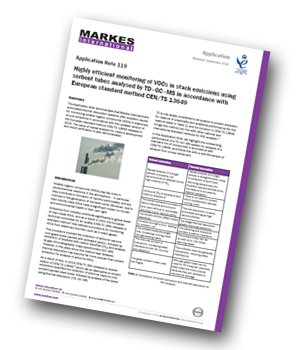Markes International has produced an application note for the highly efficient monitoring of VOCs in stack emissions using sorbent tubes analysed by TD–GC–MS in accordance with European standard method CEN/TS 13649. The value of repeat analysis for method development and result verification is also demonstrated.
 Introduction
Introduction
Volatile organic compounds (VOCs) play key roles in photochemical reactions in the atmosphere – in particular, they contribute to formation of harmful particulates, and are involved in the generation of low-level ozone. Moreover, due to their toxicity many VOCs have a significant impact on human and environmental health in their own right. Emissions from industry contribute significantly to global levels of man-made VOCs, and as a result in 2001 the European technical committee for air quality (CEN/TC 264) released a standard method that defined a procedure for monitoring VOCs from stationary sources, such as in stack gases.
 In this application note, the outstanding performance of a TD–GC–MS system for analysis of a standard mix of compounds in accordance with CEN/TS 13649 is demonstrated, and followed with a real-life sample of exhaust from a busy restaurant.
In this application note, the outstanding performance of a TD–GC–MS system for analysis of a standard mix of compounds in accordance with CEN/TS 13649 is demonstrated, and followed with a real-life sample of exhaust from a busy restaurant.
Experimental
The sampling and analytical protocol used in this study is fully compliant with the method stipulated in CEN/TS 13649.
Real-world Sample
300 mL of air is taken from the exhaust of a restaurant during a busy lunchtime period, using an ACTI-VOC™ low-flow pump (Markes International).
This application note demonstrates that Markes International’s automated, cryogen-free thermal desorption systems offer:
- excellent results for monitoring VOCs from stationary source emissions in accordance with the European standard CEN/TS 13649
- improved performance and simplicity compared to solvent extraction
- straightforward method development and validation of results because of the ability to carry out sample splitting and re-collection for repeat analysis in an automated fashion.




